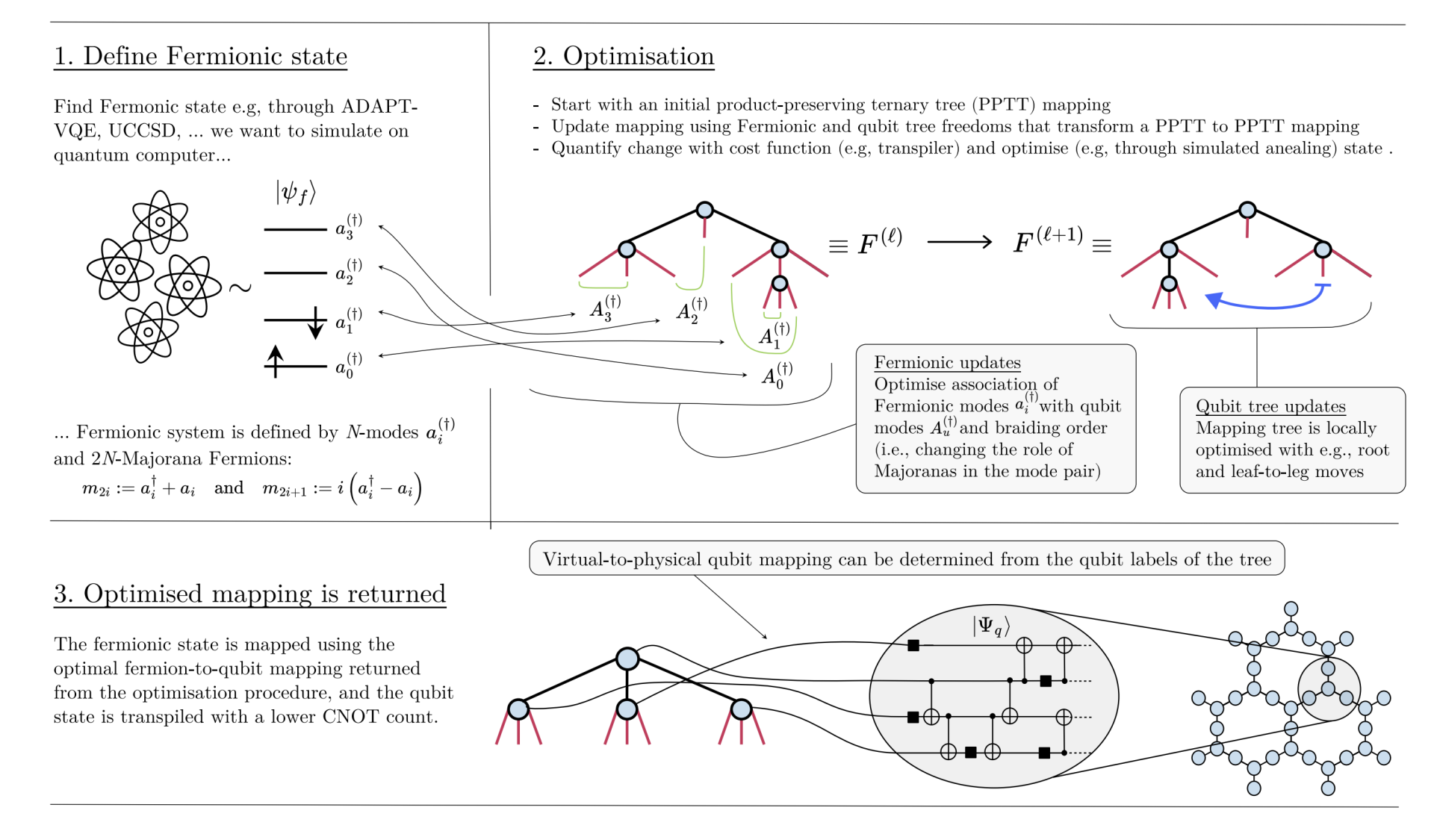Quantum computers could revolutionize fields like quantum chemistry and materials science by efficiently simulating Fermionic systems, which include particles like electrons and protons. However, current quantum devices have limitations, such as a small number of qubits and error-prone gates. To address this, researchers have introduced a technique called treespilation for efficiently mapping Fermionic systems, aiming to minimize the number of error-prone CNOT gates required. This technique could potentially make quantum computations more efficient and accurate, enhancing the ability of quantum computers to simulate Fermionic systems. However, further research is needed to refine and validate this technique.
What is the Potential of Quantum Computers in Simulating Fermionic Systems?
Quantum computers have the potential to revolutionize various fields, including quantum chemistry and materials science, by efficiently simulating Fermionic systems. Fermionic systems are a type of quantum system that includes particles like electrons and protons. The simulation of these systems is crucial for understanding and predicting the behavior of various chemical and physical processes. However, the simulation of Fermionic systems on classical computers is computationally expensive and often infeasible due to the complexity of quantum mechanics.
To overcome this challenge, researchers have been exploring the use of quantum computers. Quantum computers operate on quantum bits, or qubits, which can exist in multiple states at once, unlike classical bits that can only be in one state at a time. This property allows quantum computers to process a vast amount of information simultaneously, making them potentially more powerful than classical computers for certain tasks, such as simulating Fermionic systems.
However, quantum computing is still in its early stages, and current quantum devices have limitations, such as a small number of qubits, restricted qubit connectivity, and error-prone gates. These limitations make it difficult to execute deep circuits required for quantum algorithms. Nevertheless, recent experiments have demonstrated the potential of today’s quantum devices in solving complex problems, especially when combined with classical computing.
How Does the Fermion-to-Qubit Mapping Work?
To simulate Fermionic systems on a quantum computer, researchers typically start by choosing a Fermion-to-qubit (F2Q) mapping. This mapping encodes the Fermionic problem in the qubits of a quantum computer. The properties of the system are then inferred through measurements of the qubit state. One approach to this is the Variational Quantum Eigensolver (VQE), which approximates the qubit representation of a target Fermionic state, such as the ground state of a Fermionic Hamiltonian.
The VQE algorithm starts by deriving a qubit Hamiltonian from the desired Fermionic Hamiltonian using an F2Q mapping. Then, a parameterized quantum circuit, known as an ansatz, is designed. Finally, the circuit parameters are optimized using a classical optimizer to minimize the energy of the current quantum state for the qubit Hamiltonian.
What is the Role of CNOT Gates in Quantum Computing?
In quantum computing, the Controlled NOT gate, or CNOT gate, is a type of quantum gate that is used to create entanglement between qubits. Entanglement is a fundamental property of quantum mechanics where the state of one particle is directly related to the state of another, no matter the distance between them. This property is crucial for the operation of quantum computers.
However, CNOT gates are noisy and error-prone, contributing to computation errors. They also take longer and have lower fidelities compared to single-qubit gates. Therefore, reducing the number of CNOT gates is important for improving the efficiency and accuracy of quantum computations.
One promising variant of VQE is the Adaptive Derivative-Assembled Pseudo-Trotter (ADAPT-VQE) algorithm, which optimizes for the target state by sequentially adding elements from a predefined candidate gate set, known as a pool. The choice of the operator pool significantly affects the convergence and circuit cost in qubit space.
What is the Treespilation Technique?
In a recent study, researchers introduced a technique called treespilation for efficiently mapping Fermionic systems using a large family of favorable tree-based mappings. This technique aims to minimize the number of CNOT gates required to simulate chemical ground states.
The researchers observed significant reductions in CNOT counts on full connectivity, limited qubit connectivity-type devices such as IBM Eagle and Google Sycamore. In many instances, the reductions achieved on these limited connectivity devices even surpassed the initial full connectivity CNOT count. This suggests that the treespilation technique could significantly improve the efficiency of quantum computations.
What are the Implications of this Research?
This research has significant implications for the field of quantum computing. The treespilation technique could potentially make quantum computations more efficient and accurate, bringing us one step closer to realizing the full potential of quantum computers.
Moreover, the technique could improve the CNOT and parameter efficiency of QEB and qubit-ADAPT-VQE protocols, which are currently the most CNOT-efficient VQE protocols for molecular state preparation. This could further enhance the ability of quantum computers to simulate Fermionic systems, benefiting fields like quantum chemistry and materials science.
However, more research is needed to further refine and validate this technique. As quantum computing continues to advance, techniques like treespilation will play a crucial role in overcoming the current limitations of quantum devices and unlocking their full potential.
Publication details: “Treespilation: Architecture- and State-Optimised Fermion-to-Qubit
Mappings”
Publication Date: 2024-03-06
Authors: Aaron Miller, Adam Glos and Zoltán Zimborás
Source: arXiv (Cornell University)
DOI: https://doi.org/10.48550/arxiv.2403.03992

